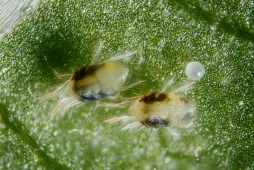Phlebodium pseudoaureum, a large fern
Phlebodium pseudoaureum grows in the forests of America and western India. This hardy fern, a member of the Polypodiaceae family, is distinguished by its large wingspan and glaucous-green foliage.
How to recognize Phlebodium pseudoaureum?
Phlebodium pseudoaureum is much taller than its cousins, phlebodium aureum 'Davana and phlebodium aureum 'Blue Star. It grows to over a metre in height and has a bushy habit.
It is an epiphytic fern that spreads its territory thanks to a subaerial creeping rhizome. Brown and covered with fine scales, it resembles a rabbit's foot.
The glaucous-green fronds measure up to 1.5 meters. Narrow and lanceolate, they are sharply divided on either side of the rachis. Foliage is evergreen. But when the temperature drops too low, the leaves fall off. They grow back when the fine weather returns.
Phlebodium pseudoaureum doesn't need flowers or fruit to multiply. It produces sori on the underside of its fronds all year round. These small, raised yellow, brown or orange spots contain sporangia. Once disseminated by the wind, these cells give rise to new plants.
The variety is non-toxic. You can add it to your collection even if you share your space with pets and small children.
Our maintenance tips
Phlebodium pseudoaureum does not like direct sun or cold. Find a bright spot for your plant, away from the strongest rays and draughts. They also hate getting their hearts wet. When watering, moisten the substrate on the sides, around the foliage.
Watering
Phlebodium pseudoaureum can withstand neither drought nor excess water.
Before watering, check the condition of the potting soil. The surface must be at least one centimeter dry.
Before watering, check the condition of the potting soil. The surface must be at least one centimeter dry.
Spray
In the wild, phlebodium pseudoaureum benefits from high humidity. Spray it regularly with non-calcareous water to bring it closer to its natural environment.
Fogging will also keep red spiders and other pests away.
Repotting
Every spring, repot your Phlebodium pseudoaureum to give it more space.
Get a pierced pot one size larger than the previous one. Phlebodium pseudoaureum has shallow roots. The plant grows mainly in width. You can therefore choose a pot that is wider than it is tall.
Line the bottom with clay balls. For the substrate, prepare a mixture containing two-thirds potting soil for green plants and one-third sand. You can add a little perlite to lighten it. Pour a little of your potting soil into the pot.
Plant your Phlebodium pseudoaureum in the center and top up with substrate. The rhizomes should be flush with the surface and the roots buried. Water copiously with non-calcareous water at room temperature.
Fertilization
To promote the growth of your Phlebodium pseudoaureum, apply fertilizer in spring and summer.
Add nutrients with a green plant fertilizer.
Prune
To encourage the growth of your Phlebodium pseudoaureum, prune regularly.
Cut withered or dried fronds with clean, sharp scissors.
Plantation
When the risk of frost has passed, it's time to plant.
Soak the rootball in water at room temperature.
Choose a spot in partial shade, sheltered by a tree or facing north, for example. Dig a hole twice the size of the root ball. Fill the bottom with heather or leaf compost.
Plant phlebodium pseudoaureum. Make sure the top of the rootball is level with the ground. Fill in with soil and water to encourage rooting. You can then mulch the base to keep the soil cool.
Cutting
Cutting is carried out during the strong growth phase, generally in spring and early summer.
When repotting, separate a rhizome with one or two fronds.
Pour a bed of clay balls into a pierced pot. Then add potting soil for green plants, mixed with sand (two-thirds potting soil to one-third sand).
Plant your cutting in the center. Water generously, until the water runs off through the drainage holes.
Diseases / Threats
Information
| Family | Polypodiaceae - Polypodiaceae |
| Type | Phlebodium - Phlebodium |
| Species | Phlebodium pseudoaureum - Phlebodium pseudoaureum |
| Lifecycle | Perennial |
| Foliage | Evergreen |
| Exposure | |
| Substrats | |
| Planting methods |
Open ground In pots |
| Categories | |
| Tags |
Beginner Soiffarde |
| Origins |
South Asia Central America South America |
| Hardiness (USDA) | 9a |
| Leaf color |
|
Discover plants from the same family
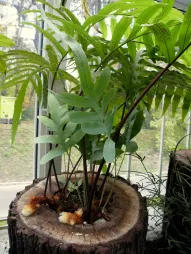
Golden polypod
Discover
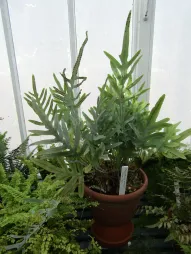
Phlebodium aureum 'Blue Star
Discover
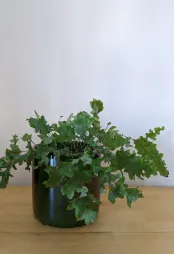
Phlebodium aureum 'Davana
Discover
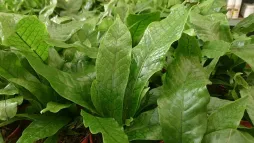
Alligator fern
Discover













